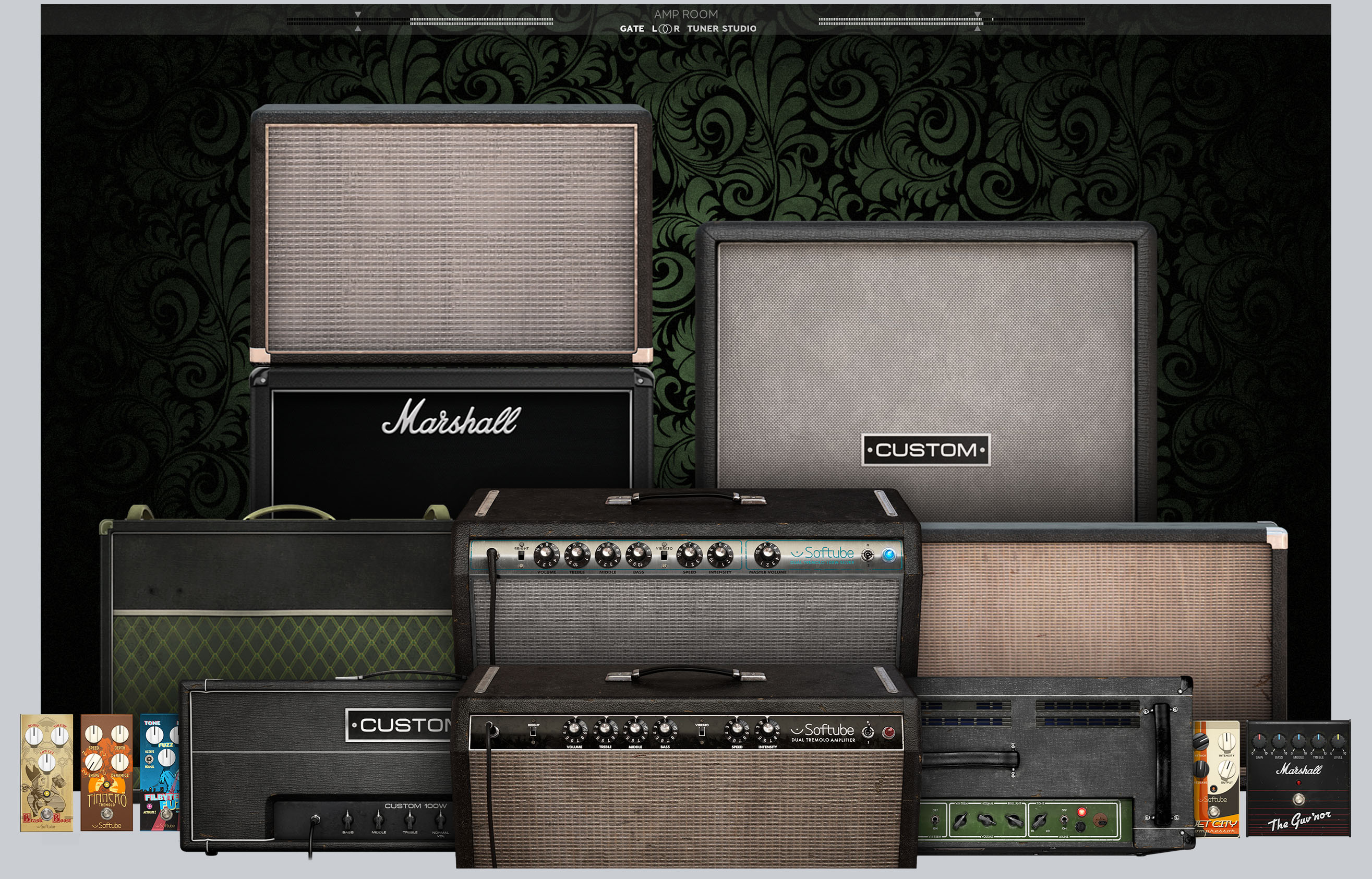

User Manual
Getting started (quick start-manual)
Suite Gear
Amplifiers
Cabinets
IR loader LoadIR module
Pedals and Studio Effects
Credits
Getting started (quick start-manual)
Presets
Amp Room factory presets are your friend for both quickly learning how Amp Room works and for finding great sounds fast. You can find factory and User presets both here:
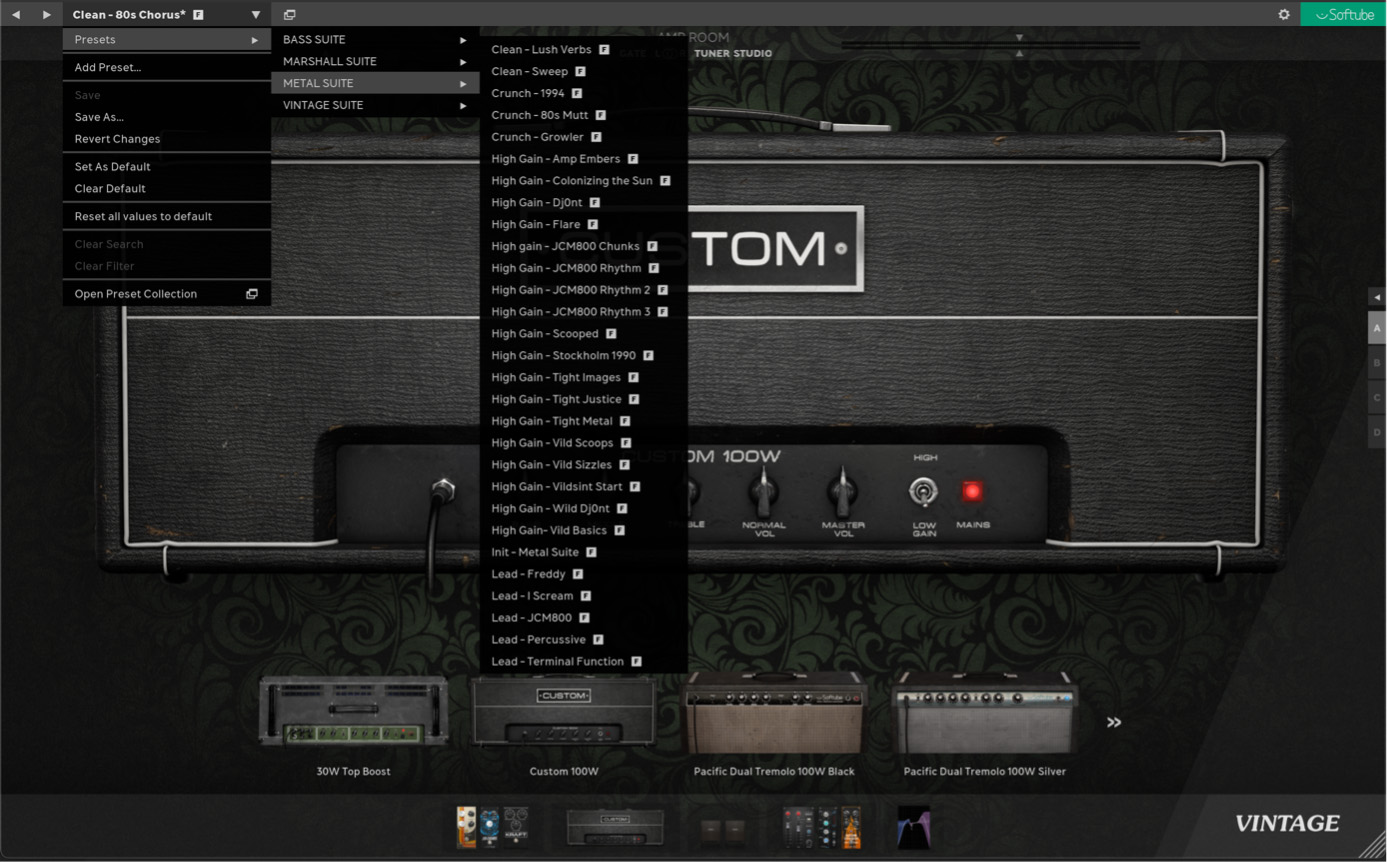
And here. This will open Preset Collection in a pop-up window. See the Preset Collection manual for more information.
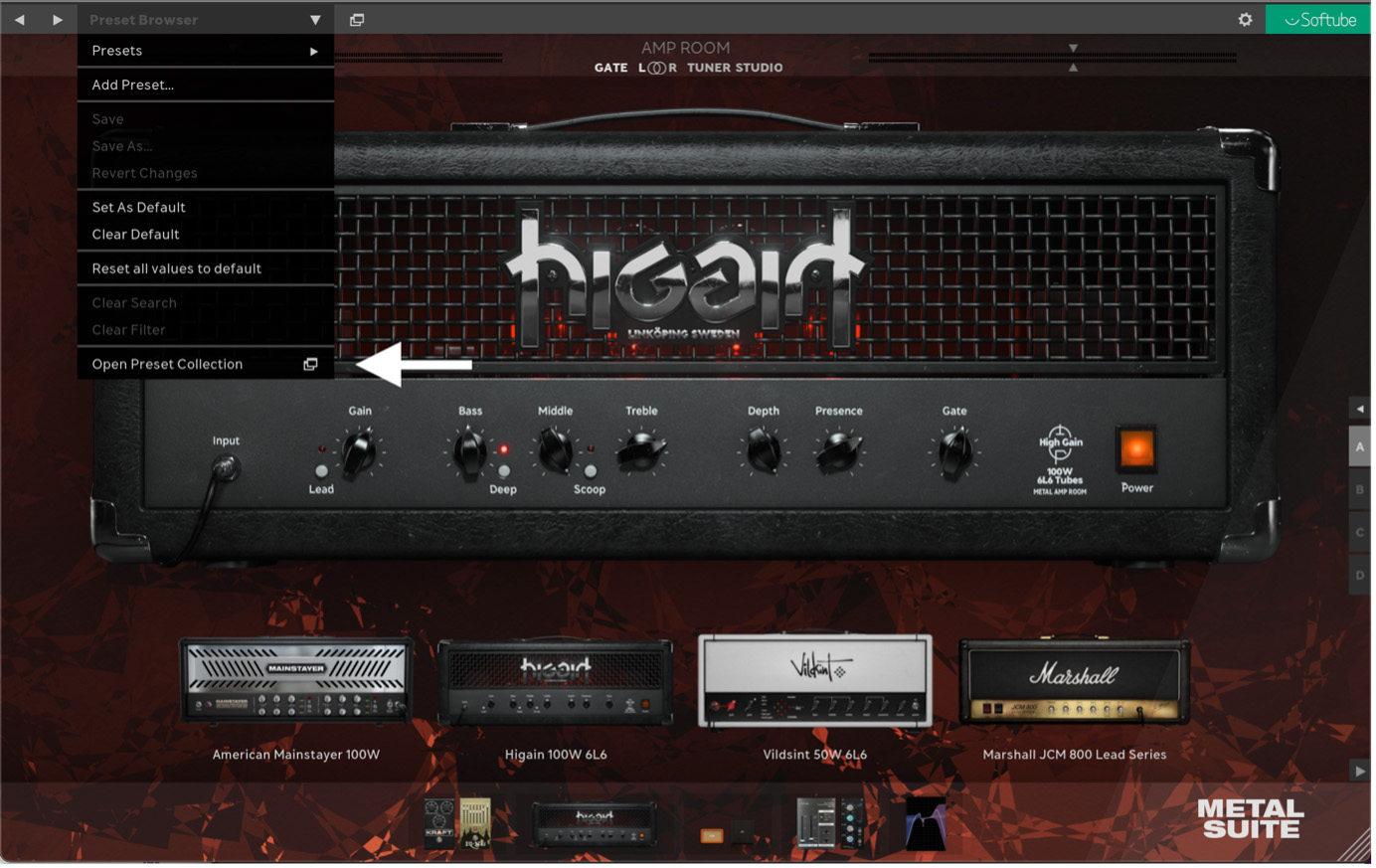
Switching between Suites
If you own more than one Amp Room Suite, you can switch between Suites by clicking on the Suite selector and selecting another Suite in the list. Choosing a preset from another Suite will automatically switch Amp Room to the Suite where the preset belongs.
The currently loaded Suite (see arrow) is activated on mouse-over. To deactivate this mouse-over pop-up, see “Settings” (cog wheel, top right corner).

Note: all current signal chain progress will be lost when switching to another Suite/preset.
When loading a Suite, only the content that comes with it will show in the amp and cab section. If you own multiple suites, you can always access content from other suites by clicking the "Show all" button in the amp and cab section. Click again to hide non-suite specific content. The pedal and effects sections always show everything.
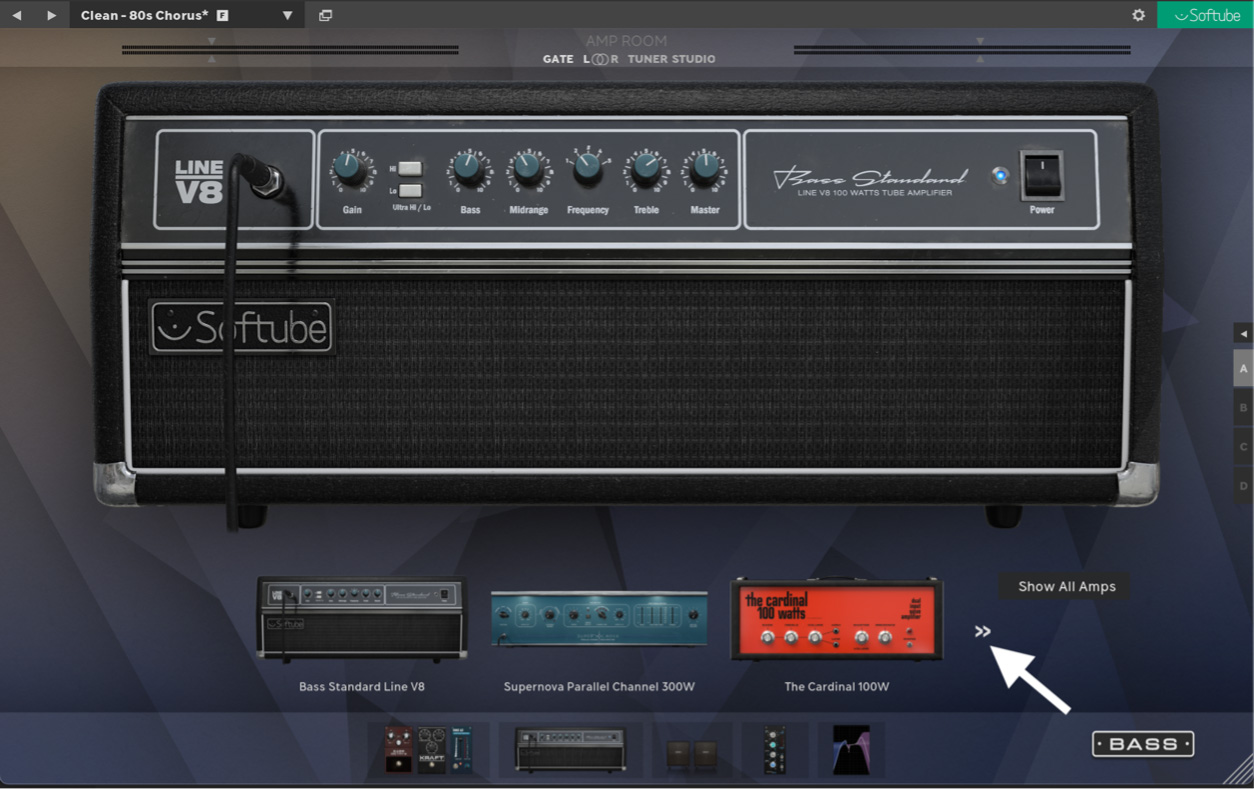
This concludes the Suite Quick Start manual over Amp Room. We strongly recommend that you also check out the main Amp Room manual for information on Studio mode and all the over features and functions of Amp Room.
Note: Apart from the gear that is included in the Suite, all Amp Room Ready Softube products that you own will also be accessible automatically inside Amp Room. For a complete list of Amp Room Ready plugins, please see the Amp Room Ecosystem page.
Pacific Dual Tremolo 100W Black
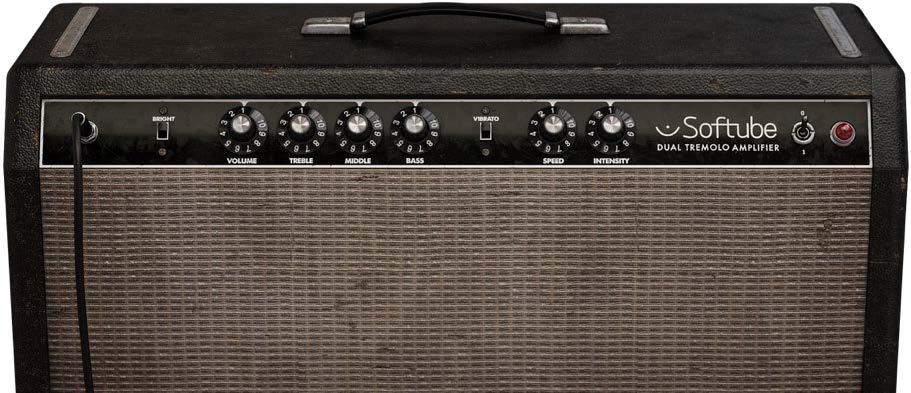
This is a 1966 BF version of this classic combo amplifier. Known for its clean sound it is also perfect for getting semi-dirty blues tones with.
The tone stack, and in particular the bass knob, affects the amount of distortion to a high degree. If you need a crystal clean sound, try backing off on the bass a bit.
The volume knob controls both the preamp and power amp distortion. Bright turns on a high frequency boost, although this only works at lower volumes.
Bass, middle and treble knobs adjust the tone, but also controls the amount of distortion. Lastly, the vibrato on this amp is actually a tremolo. Just like on the actual amp.
Pacific Dual Tremolo 100W Silver

Following in the footsteps of its older sibling (the Pacific Dual Tremolo 100W Black) the Silver has definitely made a name for itself over the years since it first saw the light of day in the late 60s.
Similar to the Pacific Dual Tremolo 100W Black, the Silver tone stack can be used to introduce more distortion of the signal when pushed hard. What the Silver has that the Black hasn’t however, is a master volume control. It will allow you to push the power amp even further into distortion territory or, when turned down, let the tone stack handle the overdrive.
Distortion aside, this amp can deliver the most beautiful and chimey clean tones as well. All in all, a very versatile and legendary amp in its own right!
Custom 100W

This is a late 70s British guitar amp which is often used for both classic rock bass and guitar.
We recommend you to experiment with both volume controls. Normal volume is the preamp distortion and master volume controls the power amp distortion. The preamp distortion is very grainy and characteristic while the power amp distortion is lot smoother.
If you are using the Custom 100W for bass guitar you might want to set the input gain switch to low to back off a bit on the preamp distortion unless you want a lot of gunk in the tone (which is also nice!).
30W Top Boost
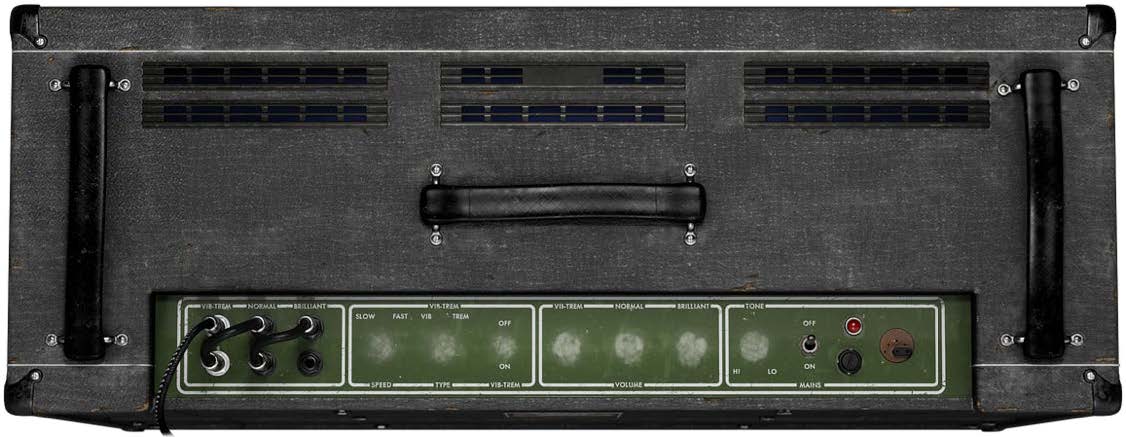
A 1964 3-channel, 6-input AC30 “Treble” model. This is a quirky amp, but once you understand the layout it’s quite easy. It has three channels – Vib-Trem, Normal, and Brilliant – with separate inputs.
In order to use all channels at the same time, the player usually patches these inputs together, and that’s what we’ve done in this version. Each channel has its own volume control, and you can blend these to get the sound you want.
The Vib-Trem channel has vibrato and tremolo, and the vibrato is the hero of this amp. You cannot set the intensity of the effect, but you can use one of the other two channels to blend in a “dry” signal. The Vib-Trem channel is also the one with the most distortion, since it features an extra tube stage before (!) the volume control.
The Vib Trem switch selects which of the two effects should be used, and the speed of the modulation can be set to Slow, Medium, of Fast with the Slow Fast switch.
The Tone knob cuts the treble frequencies.
A common application is to put a boost or overdrive pedal in front of this amp and use the output volume of that pedal to shape the amount of distortion in the amplifier.
Note: The Tone knob operates contrary to most other knobs; turning it to the right reduces the highs. Less is more.
Pacific Dual Black 2x12
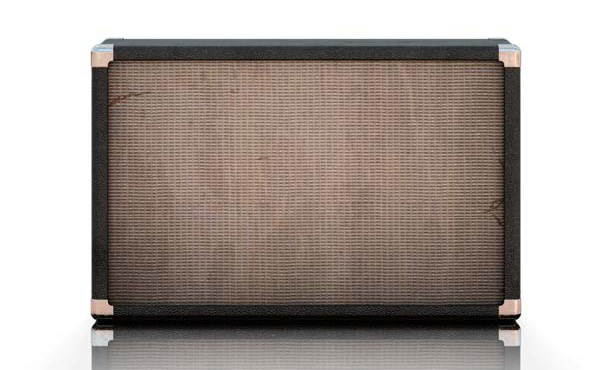
The 1966 cab speakers taken from the Pacific DT 100W Black combo amp. Legendary for both its cleans and dirtiness.
Speaker: Oxford 12T6 Blue
Pacific Dual Silver 2x12

This cab section taken from the 1968 Pacific DT 100W Silver combo perfectly captures the punch and overall ability of this cabinet.
Speaker: Celestion G12V-70
Custom M 4x12
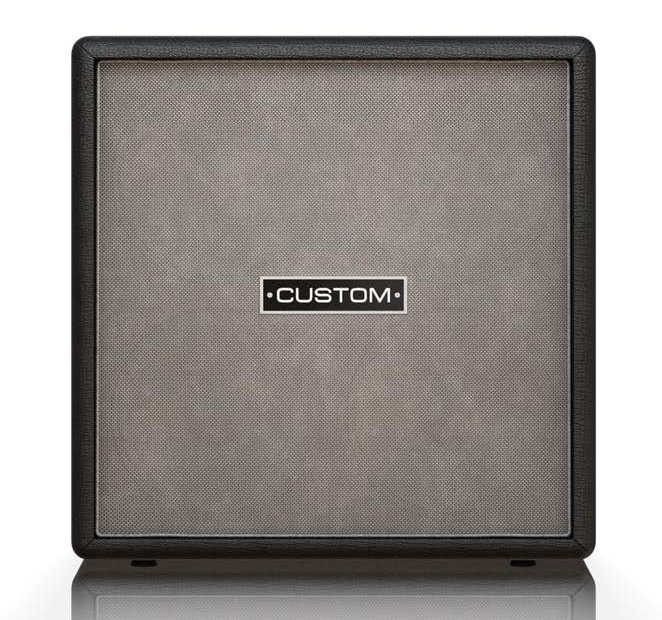
Being an integral part of the "British Invasion" of the 60", the Custom brand delivered some of the most well-known albums and sounds of the 70s as well. This cabinet has a warm sound to it, lending itself to be shaped into anything you want.
Speaker: GSP12/175-16HW
Top Boost Blue 2x12
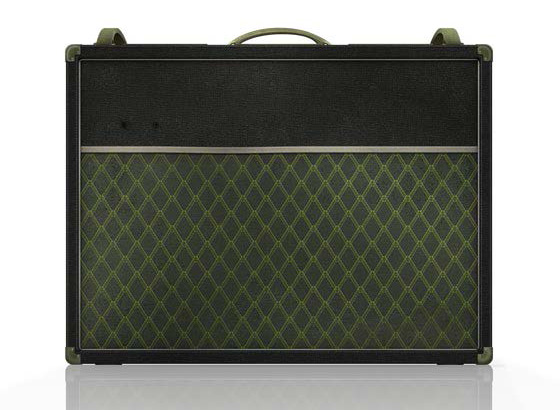
The 1964 cab section of the 30W Top Boost open back combo amp, almost entirely synonym with delivering the sound of the "British Invasion" in the 1960s.
Speaker: Celestion Alnico Blue 15W
Marshall 1936 Classic 2x12

This Marshall 1936 cabinet has been refitted with glorious-sounding Greenback speakers, giving the cab that classic Marshall stack mid-range tone, along with tempered low-end and soft highs.
Speaker: Celestion G12M-25 Greenback
LoadIR
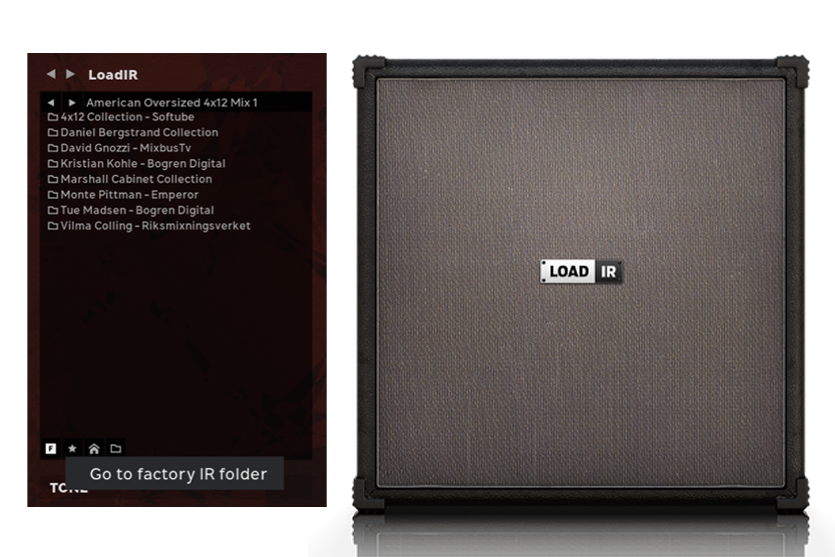
Load your own impulse responses (IRs) to create a totally customized signal chain. Any .wav file of standard sample rates and regardless of length can be uploaded into LoadIR, however only max 1 second, counting from the start, will be used.
Click the F (for Factory presets)-button to access the included Producer IR Packs and much more.
Included in the cabinet section is the IR loader module LoadIR. Locate it by clicking “Show All Cabs” in the cabinet section and looking last (far right) in the cabinet Gear menu.
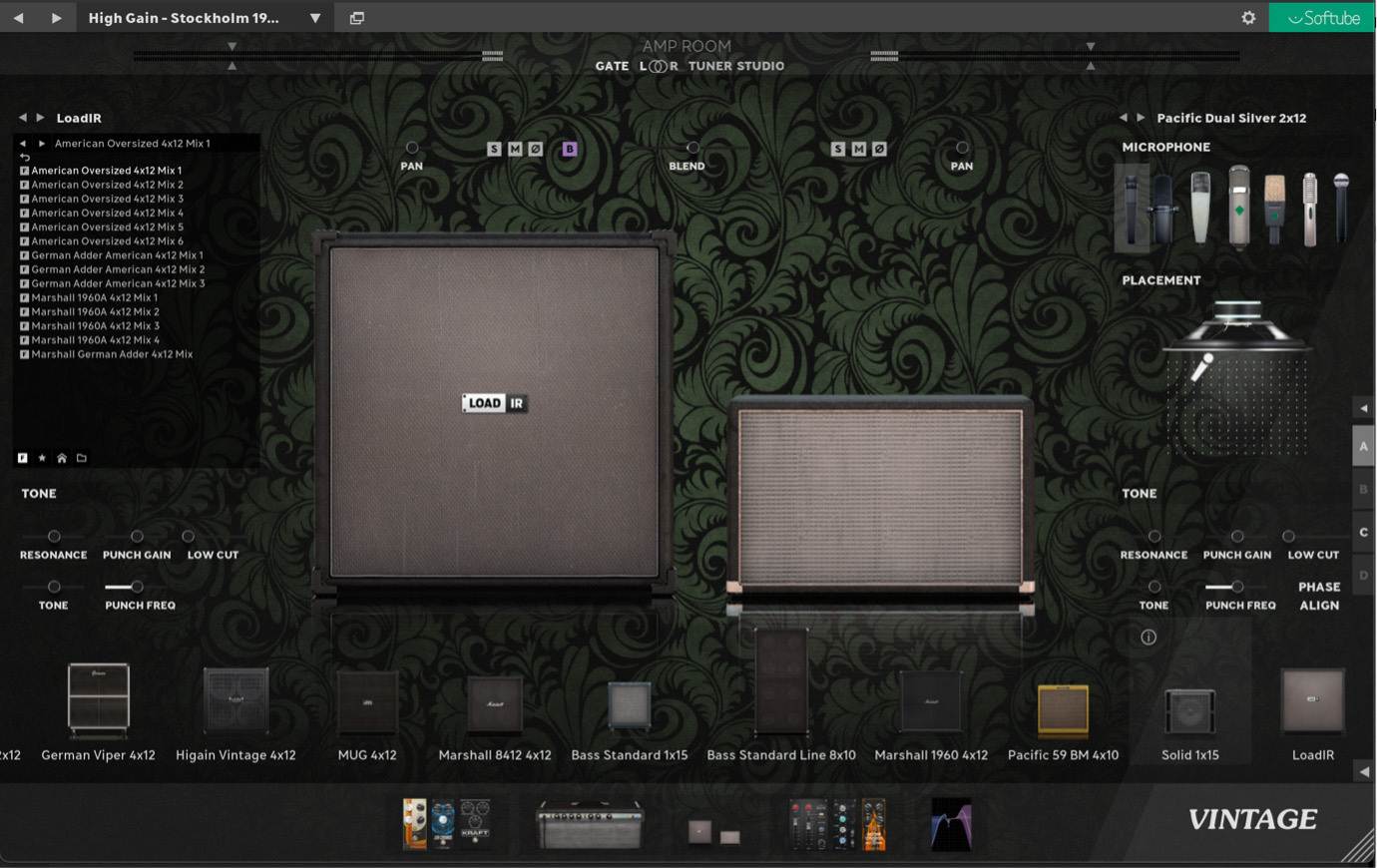
Microphone selection and positioning is not available for IRs, but the Tone controls are.
Step through the IRs by either the arrows next to the IR file name or by clicking directly in the drop-down list.
Clicking on the F icon at the bottom of the IR selection window will take you to the factory included IR folders. Click on a folder to access it. Click on the curved arrow to take you one step higher in folder hierarchy.

Every IR has two options to it.
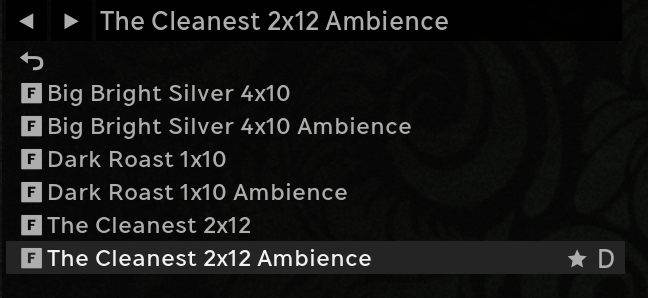
Clicking the star will add the IR to your favorites folder. Clicking the D will set the IR as the default IR when using the LoadIR module.
Access your favorites folder by clicking the star icon at the bottom of the IR selector window. Remove an IR from your favorites folder by clicking the IR’s star when in the favorites folder.

If you have your own IR library, access the OS browser by clicking the folder icon at the bottom of the IR selector window. Navigate through your HD and select an IR. The selected IR, along with all/any other IRs in the folder, will appear in the IR selector window. Step through them as you would with the factory IRs.

When a User IR is loaded and the OS folder is shown in the LoadIR display, alt/option + click the home icon to set the current OS folder as your home folder.
In the Settings menu (cog wheel icon, top right corner) there are two options that concern LoadIR. Normalizing non-factory IRs is to safeguard against third party IRs that might be harmfully loud. Automatically phase aligning third party IRs with Amp Room cabinets and IRs is for safeguarding against getting unwanted artifacts, such as phasing. Both can be unchecked but should be done so with care and at own risk.

An inserted IR will be saved along with the DAW project. Meaning, if the project is moved to another computer that does not have the selected IR locally LoadIR will still contain this IR and the signal chain will play as intended.
Saving a preset where LoadIR is used to Preset Collection will also save the IR to the preset.
The IR loader LoadIR supports .wav files in 16/24/32 bit (so basically any bit depth and in all sample rates (44.1, 48, 96, 176.4 and 192 kHz) up to 1 second for both mono and stereo IRs. If you choose to load a longer .wav file just for the heck of it, LoadIR will automatically introduce a fade after 0.8 seconds to comply with the 1 second length limitation.
Marshall Guv’nor overdrive
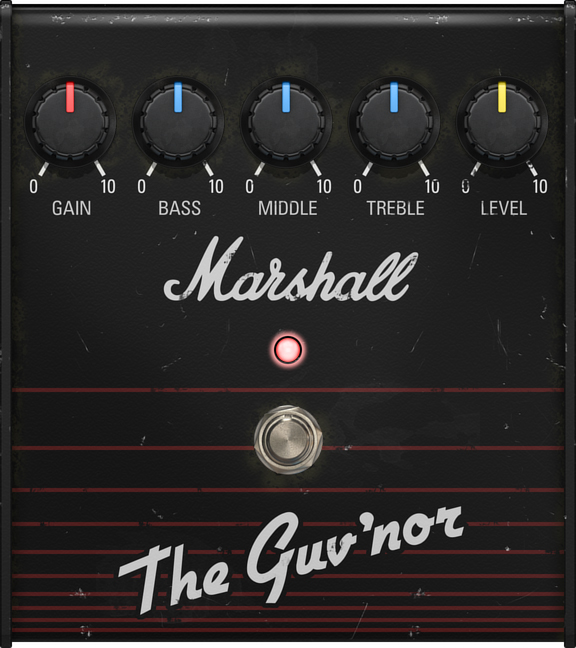
The pedal modeled here was introduced in the 1980s and provided a method for obtaining the classic Marshall sound without actually buying a Marshall amplifier. It recreates the drive tones of the JCM800 and Plexi amps with its heavy, distorted tones. It’s also flexible enough to move from transparent overdrives to heavily saturated lead tones and further into huge, distorted JCM grunt.
Gain provides drive, no doubt about that. The three Bass, Middle, and Treble controls allow you to sculpt your sound, while the Level knob sets the overall output volume.
Softube Filbyter fuzz
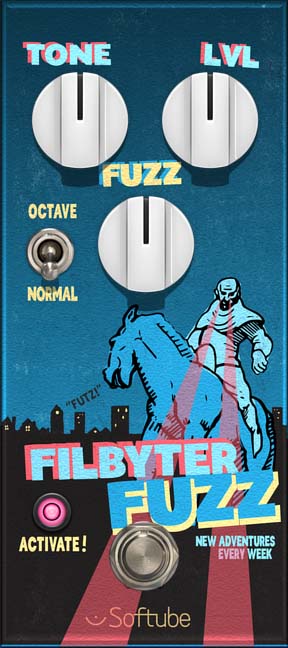
Love it or hate it, fuzz undeniably has played a huge roll throughout music history. Being one of the earliest forms of shaping a guitar tone, it might seem like a dated sound to some. But fuzz is in fact a very useful tool in creating warmth, character and atmosphere.
Since there are so many different areas where fuzz can be added for great effect, the recommendation is to just tweak it until you find the sweet spot for what you want to achieve. Activating the octave-setting will however make the fuzz a bit more extreme. A tip is to turn the fuzz knob all the way down and it can be used as an amp on its own! Getting warm and fuzzy with the Filbyter Fuzz is easy.
Apart from being a probable historical figure one thousand years ago in the Linköping area, Folke Filbyter is also a statue in the city’s main square.
Softube JJB chorus
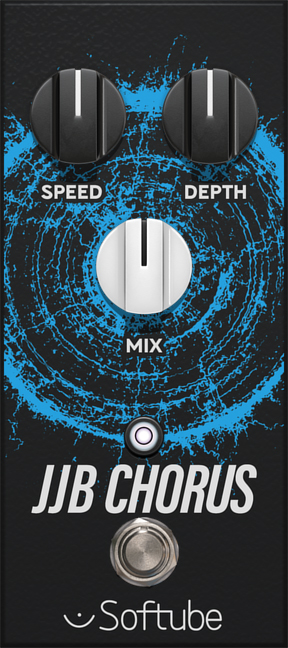
The chorus effect will bring a sweeping movement to almost any sound source. Overuse will bring back strong 80’s vibes.
This pedal adds a slight stereo image to a mono sound (if the track output is set to stereo). The Speed knob has a range from 0.3 to 9 Hertz. That’s the rate of the modulation. For reference, a Leslie cabinet rotates at approximately 1 Hertz (slow setting) and 8 Hertz (fast setting). Depth determines the depth of the modulation and Mix takes you from a dry to a fully wet sound.
JJB are the initials of Jöns Jacob Berzelius, a native of Linköping and one of the fathers of modern chemistry.
Softube Jet Town compressor

A compressor can affect the dynamics of your instrument in a big way. This pedal can be used on an electric guitar to boost the soft rhythmic noises for a funkier sound. Or on a bass to flatten out the volume, so that all notes get a more even loudness. Running an acoustic guitar through Jet Town can affect not only the overall loudness but also the attack and the length of the notes. There are several pop recordings with a bit too much compression on acoustic and electric pianos, giving them quite different sounds. And, of course, you nearly always use a compressor to tame vocals.
Attack can be set from 2 to 100 ms, and the Release range goes from 50 to 500 ms. Intensity sets the compressor threshold, i.e. the level where compression starts to kick in. In short: Increase the Intensity value to get more compression. Finally, use Output to balance the overall output of the pedal by ± 21 dB.
Jet Town is a reference to Linköping being Sweden’s number one aviation city. Airplane manufacturer SAAB AB has had its aerospace headquarters in the city since the early 1900s.
Softube Lion Head vibrato
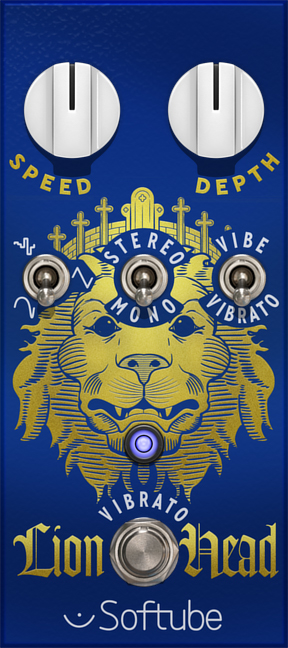
Try placing the Lion Head pedal after a cleanish amp, use the Random waveform setting and be gentle with Speed and Depth to add some dimension to your sound. Or place it after a dirty amp and play around with the Vibe mode and Multisine waveform setting to bring back memories from the past. Alternatively, dial up the Speed and Depth to max and enter the experimental zone!
Don’t forget to try out the Stereo setting either. But do so on your own risk! This pleasant effect might keep you busy long after your intended bedtime.
A lion’s head is the Linköping city coat of arms and is a frequent symbol of the local sports teams.
Softube Tinnerö tremolo

Time to usher back the sound of the 50’s!
Experiment with the placing of the Tinnerö in the signal chain. Speed adjusts the number of wave cycles per minute, in this case, ranging from very low to very high. The Speed value can in fact be set so slow that striking a note or a chord might coincide with a “quiet” wave phase. Use the Dynamics knob to blend in more of the direct signal to compensate for such events. Also, if Dynamics is turned very high up while playing long notes or chords, the tremolo effect with only appear towards the tail end of what is being played. This is where a high Speed setting works particularly well!
If you however wish to have a more traditional tremolo effect, set Dynamic to zero and tweak Depth to your liking.
Tinnerö is an oak woodland bordering to Linköping and is Europe’s most important region for biological diversity linked to the oak tree. As such, it is a designated national treasure.
Softube Brask boost
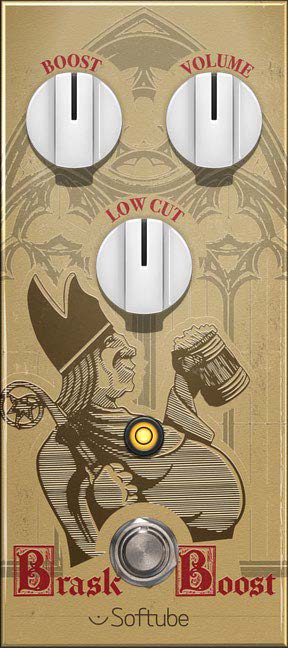
Boosting treble frequencies was the standard practice throughout the 60s and 70s to achieve a more aggressive sound. Dial the volume knob on the guitar back a bit and there is a world of sweet tones to discover!
Brask, an early 1500s bishop of Linköping diocese, avoided execution at the Stockholm Bloodbath through a hidden note which later coined the common Swedish proverb "Brasklapp"
Softube Doom Chvrch reverb
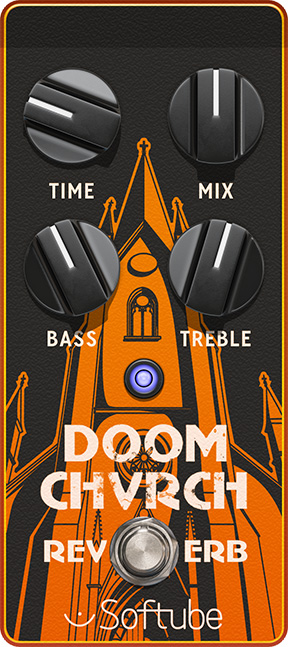
The Doom Chvrch reverb is a marriage between vintage and modern. Some parts, such as the modulation and diffusion, are inspired by the classic EMT 250 reverb, while the reverb tank itself comes from the huge hall we built for the Parallels® instrument. It was designed to allow you to go from a short “boxy” room sound, to epic and almost infinite perturbations that evolve over time into something completely different. It was never intended to sound realistic; it was designed to sound good.
Doom Chvrch is a stereo reverb that will give you a stereo output, even if the input is a mono signal. You can therefore use it in subtle amounts to give some depth to your track. The Time knob provides almost infinite reverberation. Mix adjusts the dry/wet balance and the Bass and Treble controls let you adjust the overall tone of the reverb effect.
“Doom Chvrch” is a local wordplay on the Domkyrka (Cathedral) of Linköping. Founded in the 13th century, it is a prominent part of the Linköping skyline.
Softube Wildboar delay

Delay or echo is one of the most desirable and necessary effects for many musicians, not only synth players, singers, and guitarists. When introduced in the fifties, tape effect units provided a method of adding space around singers and made instruments sound more exciting. Later it became a way of adding rhythmic effects in musical arrangements.
Delay sets a delay time from 20 to 1,000 ms. The Mix knob goes from completely dry to 50/50 (at 12 o’clock) to delay only. Feedback gives you anything from a single delay to almost infinity, and the repeats continue even after you turn the pedal off. If you want to quickly cut off the echoes, just turn down the Feedback knob. Tone does not affect the delay signal at all when set to 12 o’clock. Move it to the left to reduce treble and to the right to reduce bass.
At the module top bar there is also a Tap tempo function! Tap away to get the delay time you are looking for!
Sweden is largely covered by forest and, due to the country’s relatively low population density, rich in wildlife. The area around Linköping is particularly rife with wild boar.
Kraft overdrive
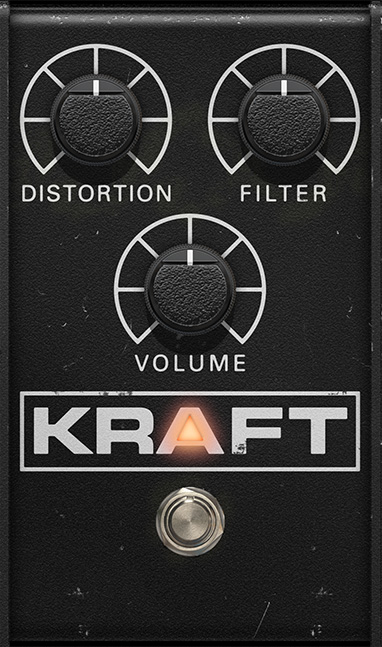
An overdrive/fuzz/distortion pedal masterpiece. Probably featured on more of your favorite recordings than you realize, and that is almost regardless of music genre.
The Kraft pedal transitions easily between warm, tempered overdrive to heaving chunks of heavy gain all around. Thanks to its renowned tone filter the output signal never lacks “muscle” or body and the pedal works just as well for bass as it does for guitar.
Whatever you are looking for in the gain, fuzz and/or distortion department, this is a good place to start your search at.
Softube Trollegater noise gate

Stacking up a load of pedals, especially those that add some kind of distortion, may result in a huge amount of noise building up. A noise gate can come in handy if noise becomes a problem.
One method is to put the gate last in the chain. That way, you will get rid of all unwanted hiss and rumble from your rig. However, if you use delay and reverb effects after overdrive and distortion pedals, the noise gate may cut off the tails of those effects. You could then try placing the gate before echo and reverb.
The Trollegater will always do its best to assist you in removing noise while preserving the music, but you must give it a little help. Start by turning the Threshold knob all the way to the left. With your instrument connected and all effects on but no music playing, listen closely to the noise. Increase the Threshold knob until the noise disappears. This is your correct setting!
Trollegater (transl.: Troll + gata = troll street) is a nature reserve outside Linköping with one of Sweden's largest natural cave systems.
American Class A 25 compressor
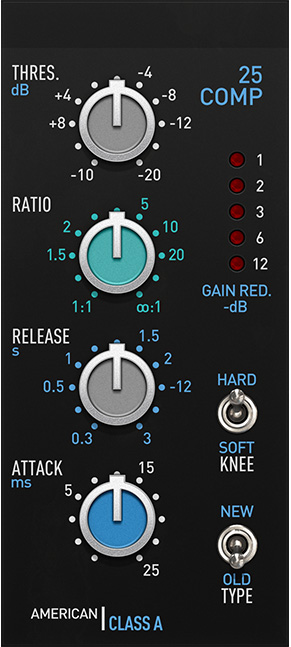
This unit is based on Softube’s take on the greatest classics of American mixing console hardware – a compressor with a famously punchy sound.
Apart from the standard compressor controls, American Class A also features a switch which allows you to choose between a feed forward or a feedback style of compressor. The feed forward (Type = New) is controlled and predictable, while the classic feedback mode (Type = Old) is more punchy.
A Hard Knee has a sharper transition between compressing and non-compressing states. A Soft Knee offers a more gradual transition, where the ratio gradually increases around the threshold. For most applications, Soft Knee is where you want to set it.
The Attack can be set between 1 and 25 milliseconds and the Release from 0.3 to 3 seconds. The Ratio knob sets the ratio which, in general, is often less than what the panel says. Threshold is adjustable from +10 to –20 dBu.
The Gain Reduction meter shows you how much the compressor squishes the sound.
You can either place it as a pedal style compressor in front of an amp, or you can use it as a mixing tool at the end of the signal chain. When using it as a mixing tool, we recommend that you listen to your guitars together with the rest of the mix. You will come a long way with just a touch of compression.
American Class A 55 EQ
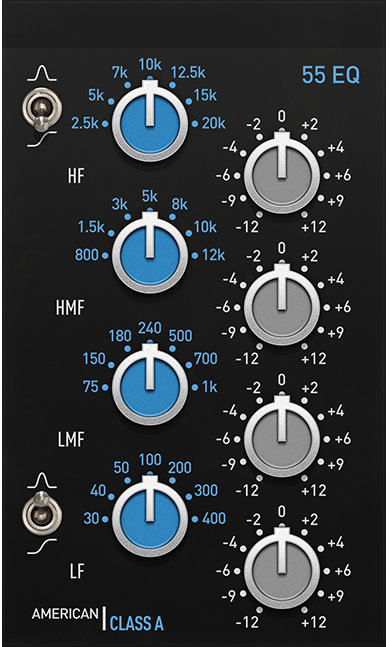
This EQ is based on a classic console equalizer that made it into a four-band 1U mastering equalizer, a Softube Console 1 strip, and now finally turns up inside Amp Room! This EQ is rock music. The weight of the mids are legendary and the punch of the low end can be heard on countless albums.
The four EQ bands each have 7 center frequencies. The Gain knobs are divided into 11 steps, ranging from –12 to +12 dB.
Both the high and the low filter can be switched between Shelving or Bell filters.
You can either use it as a pedal style EQ in front of an amp, or as a mixing tool to sculpt the output of Amp Room. Anything goes!
The Gain Reduction meter shows you how much the compressor squishes the sound.
Room Ambience RoomIR

If you connect an instrument to your sound card and run the signal through Amp Room while using headphones, you will hear a completely dry signal.
With this effect somewhere near the end of your signal chain, you can add some natural room ambience.
Five room impulse responses are available. All of them have Near and Far faders, plus you can choose to delay the Near response with a pre-set predelay time to achieve a great slap-back effect. The two Pan knobs lets you spread out the room impulses in the stereo field.
Room info:
Note: The output of this effect is in stereo. To hear the full stereo sound, you may have to switch the track in your DAW to stereo.
Patrik Jensen – Product Owner
Johan Toverland – Project Management
Stefan Aronsson – Product Marketing
Kim Larsson, Mattias Flygare, Fredrik Jansson, Anton Eriksson and Niklas Odelhom – DSP modeling
Pelle Serander, Patrik Holmström and Arvid Johnsson – Framework programming
Björn Rödseth – DSP backend programming
Niklas Odelholm – General graphic design
Ulf Ekelöf, Thomas Merkle, Nis Wegmann and Manuel Colom – Graphic design
Stefan Aronsson and Patrik Jensen – Presets
Emanuel Enbäre and Niels Nielsen– Quality assurance
Thank you to: Daniel Bergstrand @ SDFX, Kristian Kohle @ Kohlekeller Studio, Thomas Plec Johansson @ The Panic Room, David Castillo @ Studio Gröndal, Tue Madsen @ Antfarm Studio, Vilma Colling @ Riksmixningsverket, Jacek @ Bogren Digital, David Gnozzi @ MixbusTv, Monte Pittman and Mikael Almgren.